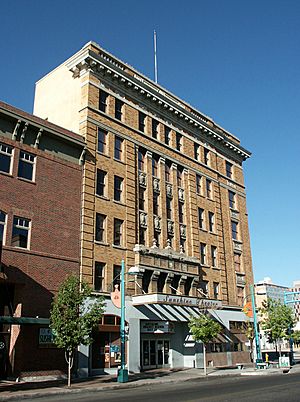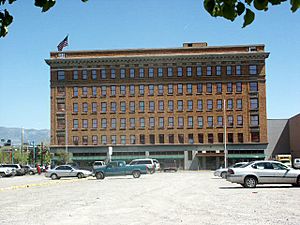Sunshine Building facts for kids
Quick facts for kids Sunshine Building |
|
|---|---|

Central Ave. facade
|
|
| Location | 120 Central Ave. SW Albuquerque, New Mexico |
| Built | 1924 |
| Architect | Trost & Trost |
| Architectural style(s) | Renaissance Revival |
| Designated | March 8, 1985 |
| Reference no. | 1170 |
|
Albuquerque Historic Landmark
|
|
The Sunshine Building is a historic six-story building located in downtown Albuquerque, New Mexico. It was built in 1924 by a local theater owner named Joseph Barnett. This special building is home to the Sunshine Theater, along with shops and offices.
For many years, the Sunshine Theater was mainly a movie theater. It showed films until the 1980s. However, it was also built to host live shows, like Vaudeville performances. Since 1990, it has become a popular place for live music concerts. Many famous bands and artists have performed there. The Sunshine Building was recognized as an important historical site in New Mexico in 1985. It is also an Albuquerque City Landmark.
The building was designed by the El Paso company Trost & Trost. It is made of strong reinforced concrete and has a front covered in yellow bricks. Its style is called Renaissance Revival. The Sunshine Building was once known for having what people believed was the very last elevator in New Mexico that was operated by a person.
One of the businesses that stayed in the building for a long time was F. D. Fogg and Company. This local jewelry store was there from 1948 to 1985. The company closed its doors in 2004 after being in business for 83 years. The TV show In Plain Sight used the outside of the Sunshine Building as the fictional office for the US Marshals' Witness Protection Service.
Contents
History of the Sunshine Building
How the Sunshine Building Was Built
The Sunshine Building was constructed between 1923 and 1924. It was built by Joseph Barnett (1866–1954), a businessman who came to Albuquerque in 1896 without much money. He worked hard in the saloon and theater business. Over time, he became one of the city's biggest property owners.
By the 1920s, Joseph Barnett already owned two theaters in Albuquerque. These were the B Theater and the Lyric. But he wanted to build an even bigger theater in his new building. He also planned to have five floors of offices. The Sunshine Building was built where an old two-story adobe building used to stand. This old building, called the White Elephant, was built in 1881 and was once a popular place for gambling and a saloon.
The design for the Sunshine Building came from the El Paso company Trost & Trost. This company also designed several other buildings nearby. These include the Rosenwald Building, the Occidental Life Building, and the First National Bank Building.
Opening of the Sunshine Theater
The Sunshine Theater first opened its doors on May 1, 1924. The first movie shown was Scaramouche, starring Ramón Novarro. The theater could seat 1,200 people. It had central heating and cooling, and it was built with fireproof reinforced concrete. It was advertised as "the most modern and beautiful theater in the southwest." Many people thought it was Albuquerque's first true movie palace.
The Albuquerque Journal newspaper reported that the opening was a "grand success." The theater was completely full for many showings. The Sunshine Theater was set up to show both movies and live performances. This included the traveling Vaudeville shows that were very popular in the 1920s. The building also had 73 office rooms on its upper floors. There were five commercial spaces on the ground floor for businesses.
Changes Over the Years
In 1935, Joseph Barnett combined his theater businesses with the Bachechi family's theaters. This included the KiMo Theater. This merger meant that most of Albuquerque's theaters were owned by the same group. By 1952, this group, called Albuquerque Exhibitors, controlled 10 local theaters. They had 170 employees.
In 1956, the company leased its theaters to a Texas-based chain called Frontier Theaters. Then, in 1967, Commonwealth Theaters took over Frontier Theaters. Commonwealth decided not to continue the lease on the Sunshine Theater when it ended in 1974. They said it was because not enough customers were coming. After that, the theater stopped showing new movies. It later started showing classic films from the 1930s and 1940s. Then, it began showing Spanish-language movies.
Saving the Sunshine Building
In 1983, there was a plan to tear down the Sunshine Building. The idea was to build a large "Festival Marketplace" in its place. Supporters of this project believed it would make the empty area around First and Central streets lively again. However, people who wanted to save old buildings were against tearing it down. They formed a group called "Save the Sunshine" committee. This debate was even reported in a national newspaper called Preservation News in 1984. In the end, the project was stopped, and the Sunshine Building was saved.
In 1990, the Sunshine Theater was changed into a live music venue. One of the first bands to play there was Soundgarden on February 14, 1990. The theater has remained one of Albuquerque's most popular places for mid-sized concerts. It continues to host live music shows as of 2023.
Architecture of the Sunshine Building
The Sunshine Building is a six-story structure. It is located on the southeast corner of Second Street and Central Avenue. The building is about 85 feet (26 meters) tall. Its base covers an area of about 75 by 140 feet (23 by 43 meters). The ground floor is covered with marble. The upper floors are faced with yellow brick.
The building's style is usually called Renaissance Revival. It has fancy brickwork and tall, flat columns called pilasters. There is also a heavy decorative ledge called a cornice and a railing with small posts called a balustraded parapet. The building is also decorated with designs like swags, medallions, and other ornaments.
Like the nearby First National Bank Building, the Sunshine Building was built with plain walls on two sides. This was done to fit in with buildings that were supposed to be next to it. By the 1980s, the Sunshine Building was the only structure left on its block. Some people criticized the "not so handsome" plain wall that greeted traffic entering Downtown. In 2001, the Century Theatres Downtown building was built next to the Sunshine. This new building now covers those plain walls.
The Sunshine Building has commercial spaces on the ground floor. It also has five floors of offices that surround the central theater area. When it first opened, the theater had 800 seats on the main floor and 400 seats in the balcony. Most of these seats were removed when it was changed for live music concerts. The stage opening, called the proscenium arch, is 27 feet (8.2 meters) wide and 24 feet (7.3 meters) high. The area above the stage, called the fly gallery, is 52 feet (16 meters) high from the stage to the grid deck. You can reach the balcony from staircases on both sides of the theater. There is also a mezzanine level with restrooms. The office section has its own entrance lobby on Second Street. The building was famous for having what was thought to be the last manually operated elevator in New Mexico. It had elevator operators working it until at least 1989.
Sunshine Theater Today
The Sunshine Theater takes up a large part of the building. It was a movie theater from 1924 until the 1980s. Since then, it has been updated and is now a very popular place for live music. The Sunshine Theater has hosted many well-known acts. These include The Strokes, Snoop Dogg, Soulfly, Deltron 3030, Stone Temple Pilots, The Smashing Pumpkins, Queens of the Stone Age, The Dead Weather, Arctic Monkeys, Modest Mouse, Rancid, Coheed and Cambria, Awolnation, Cannibal Corpse, Ratatat, Social Distortion, Pennywise, Hollywood Undead, Deftones, Nightwish, Melanie Martinez, Damian Marley and Deadmau5, among others.
The Sunshine Theater has an open floor area, a large balcony, and a bar for people aged 21 and older. In total, it can hold about 1,000 people. It is the most popular venue in the Albuquerque area for smaller but still famous acts. Many months, it hosts five or more shows. On January 28, 2023, the band Soulfly with Max Cavalera was given the key to the city at the venue by Albuquerque Mayor Tim Keller (politician).
See also
 In Spanish: Sunshine Building para niños
In Spanish: Sunshine Building para niños


